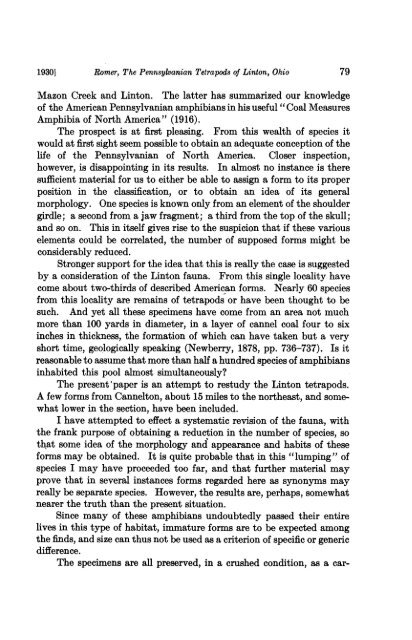View/Open - American Museum of Natural History
View/Open - American Museum of Natural History
View/Open - American Museum of Natural History
You also want an ePaper? Increase the reach of your titles
YUMPU automatically turns print PDFs into web optimized ePapers that Google loves.
19301<br />
Romer, The Pennsylvanian Tetrapods <strong>of</strong> Linton, Ohio<br />
Mazon Creek and Linton. The latter has summarized our knowledge<br />
<strong>of</strong> the <strong>American</strong> Pennsylvanian amphibians in his useful " Coal Measures<br />
Amphibia <strong>of</strong> North America" (1916).<br />
The prospect is at first pleasing. From this wealth <strong>of</strong> species it<br />
would at first sight seem possible to obtain an adequate conception <strong>of</strong> the<br />
life <strong>of</strong> the Pennsylvanian <strong>of</strong> North America. Closer inspection,<br />
however, is disappointing in its results. In almost no instance is there<br />
sufficient material for us to either be able to assign a form to its proper<br />
position in the classification, or to obtain an idea <strong>of</strong> its general<br />
morphology. One species is known only from an element <strong>of</strong> the shoulder<br />
girdle; a second from a jaw fragment; a third from the top <strong>of</strong> the skull;<br />
and so on. This in itself gives rise to the suspicion that if these various<br />
elements could be correlated, the number <strong>of</strong> supposed forms might be<br />
considerably reduced.<br />
Stronger support for the idea that this is really the case is suggested<br />
by a consideration <strong>of</strong> the Linton fauna. From this single locality have<br />
come about two-thirds <strong>of</strong> described <strong>American</strong> forms. Nearly 60 species<br />
from this locality are remains <strong>of</strong> tetrapods or have been thought to be<br />
such. And yet all these specimens have come from an area not much<br />
more than 100 yards in diameter, in a layer <strong>of</strong> cannel coal four to six<br />
inches in thickness, the formation <strong>of</strong> which can have taken but a very<br />
short time, geologically speaking (Newberry, 1878, pp. 736-737). Is it<br />
reasonable to assume that more than half a hundred species <strong>of</strong> amphibians<br />
inhabited this pool almost simultaneously?<br />
The present 'paper is an attempt to restudy the Linton tetrapods.<br />
A few forms from Cannelton, about 15 miles to the northeast, and somewhat<br />
lower in the section, have been included.<br />
I have attempted to effect a systematic revision <strong>of</strong> the fauna, with<br />
the frank purpose <strong>of</strong> obtaining a reduction in the number <strong>of</strong> species, so<br />
that some idea <strong>of</strong> the morphology and appearance and habits <strong>of</strong> these<br />
forms may be obtained. It is quite probable that in this "lumping" <strong>of</strong><br />
species I may have proceeded too far, and that further material may<br />
prove that in several instances forms regarded here as synonyms may<br />
really be separate species. However, the results are, perhaps, somewhat<br />
nearer the truth than the present situation.<br />
Since many <strong>of</strong> these amphibians undoubtedly passed their entire<br />
lives in this type <strong>of</strong> habitat, immature forms are to be expected among<br />
the finds, and size can thus not be used as a criterion <strong>of</strong> specific or generic<br />
difference.<br />
The specimens are all preserved, in a crushed condition, as a car-<br />
79
















